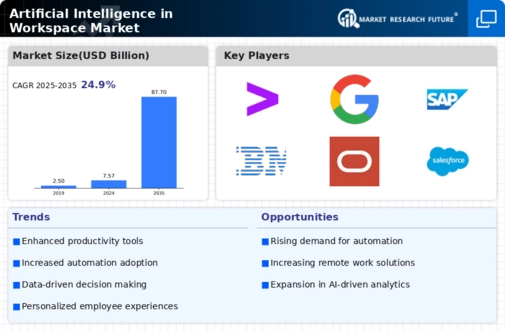Remote Work Facilitation
The Global Artificial Intelligence in Workspace Market Industry is increasingly influenced by the shift towards remote work, with AI technologies playing a pivotal role in facilitating this transition. AI tools enhance collaboration and communication among remote teams, ensuring seamless workflows regardless of geographical barriers. For instance, AI-powered project management software can optimize task assignments based on team members' strengths and availability. This trend is likely to continue, as organizations recognize the benefits of flexible work arrangements. The market's growth is indicative of this shift, with a projected CAGR of 24.95% from 2025 to 2035, reflecting the ongoing evolution of workplace dynamics.
Market Growth Projections
The Global Artificial Intelligence in Workspace Market Industry is projected to experience substantial growth, with forecasts indicating a market value of 7.57 USD Billion in 2024 and an impressive 87.7 USD Billion by 2035. This growth trajectory suggests a compound annual growth rate (CAGR) of 24.95% from 2025 to 2035, highlighting the increasing adoption of AI technologies across various sectors. The rising demand for automation, enhanced data analytics, and improved employee experiences are key factors driving this expansion. As organizations continue to invest in AI solutions, the market is likely to evolve rapidly, reflecting the transformative potential of artificial intelligence in the workplace.
Improved Employee Experience
Enhancing employee experience is a primary focus within the Global Artificial Intelligence in Workspace Market Industry, as organizations recognize the correlation between employee satisfaction and productivity. AI technologies, such as personalized learning platforms and virtual assistants, contribute to a more engaging work environment. For example, AI can tailor training programs to individual employee needs, fostering skill development and career growth. As companies invest in AI solutions to improve employee experience, they are likely to see increased retention rates and overall performance. This trend aligns with the market's anticipated growth, as organizations prioritize employee-centric strategies.
Increased Demand for Automation
The Global Artificial Intelligence in Workspace Market Industry experiences heightened demand for automation solutions, as organizations seek to enhance operational efficiency and reduce human error. Automation tools powered by AI streamline repetitive tasks, allowing employees to focus on more strategic initiatives. For instance, AI-driven chatbots can handle customer inquiries, significantly reducing response times and improving customer satisfaction. This trend is reflected in the projected market value of 7.57 USD Billion in 2024, indicating a robust growth trajectory as businesses increasingly adopt AI technologies to optimize workflows.
Enhanced Data Analytics Capabilities
Data analytics is a cornerstone of the Global Artificial Intelligence in Workspace Market Industry, as organizations leverage AI to derive actionable insights from vast datasets. Advanced analytics tools enable businesses to identify trends, forecast outcomes, and make informed decisions. For example, AI algorithms can analyze employee performance metrics to enhance productivity and engagement. This capability is crucial in a data-driven world, where organizations that harness AI for analytics are likely to gain a competitive edge. The market is expected to grow significantly, with a projected value of 87.7 USD Billion by 2035, underscoring the importance of data-driven decision-making.
Integration of AI with Existing Technologies
The Global Artificial Intelligence in Workspace Market Industry benefits from the seamless integration of AI with existing technologies, enhancing overall functionality and user experience. Organizations are increasingly adopting AI solutions that complement their current software and systems, leading to improved productivity and efficiency. For instance, AI can be integrated into customer relationship management systems to provide predictive insights and automate routine tasks. This integration not only streamlines operations but also maximizes the return on investment for existing technologies. As businesses continue to embrace AI, the market is poised for substantial growth, driven by the demand for cohesive technological ecosystems.

























Leave a Comment